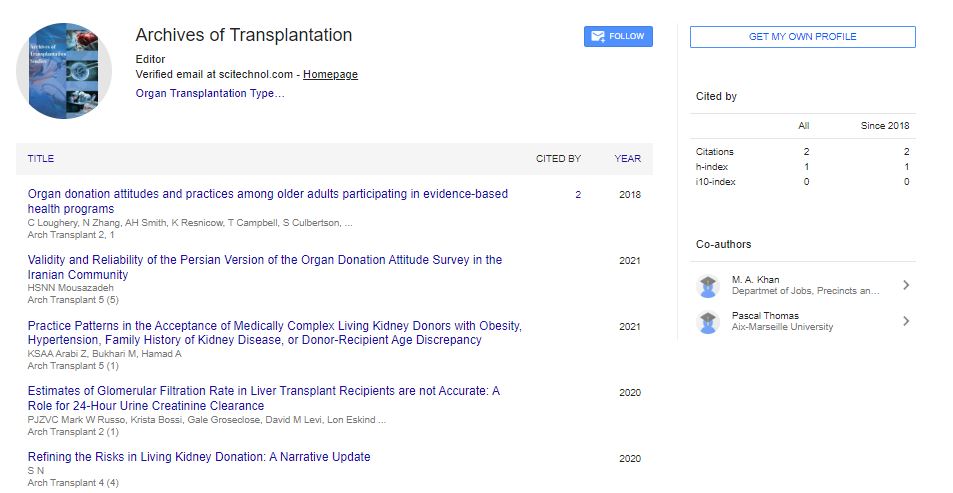Editorial, Arch Transplant Vol: 1 Issue: 1
It's Time for Personalized Medicine in Cardiac Transplantation; One Size Does Not Fit All
Marco A Caccamo*
Director of mechanical circulatory support and Assistant Professor, Indiana University, 1801 N. Senate Blvd.MPC#2 Suite 2000, Indianapolis, IN 46202, USA
*Corresponding Author : Marco A Caccamo
Director of mechanical circulatory support and Assistant Professor
Indiana University, 1801 N. Senate Blvd. MPC#2 Suite 2000, Indianapolis, IN 46202, USA
Tel: 317-962-0559
E-mail: mcaccamo@iuhealth.org
Received: April 29, 2017 Accepted: May 05, 2017 Published: May 08, 2017
Citation: Caccamo MA (2017) It’s Time for Personalized Medicine in Cardiac Transplantation; One Size Does Not Fit All. Arch Transplant 1:1.
Abstract
Does the approach of “one size fits all” apply to induction and immunosuppression in cardiac transplantation make sense? For example, does a 68 year old Caucasian male with 0% panel reactive antibodies with a left ventricular assist device (LVAD) and a driveline infection get the same induction and maintenance therapy as a 25 year old African-American female with multiple pregnancies and 85% panel reactive antibodies? Many centers the answer would be yes and we need to change this archaic way of practicing transplant medicine. There is a delicate balance between rejection and infection and with each patient that balance must be maximized. When looking at the 2015 International Society of Heart and Lung Transplant registry, approximately 50% of programs administer no induction therapy, another 25% administer intravenous basiliximab and another 25% percent administer intravenous thymoglobulin. This trend hasn’t changed in several years. The method that is used is program specific and to be honest, reminds me of the times of the “Wild West”. I have had the luxury of training at 3 different sites and have been an attending at one institution and each program does it differently. We have data to suggest maybe personalized medicine is not such a bad idea. In fact, in 2012 the transplant groups from Johns Hopkins and Yale published in Circulation a 13 point score to help predict rejection after cardiac transplantation
Keywords: Cardiac transplantation
Does the approach of “one size fits all” apply to induction and immunosuppression in cardiac transplantation make sense? For example, does a 68 year old Caucasian male with 0% panel reactive antibodies with a left ventricular assist device (LVAD) and a driveline infection get the same induction and maintenance therapy as a 25 year old African-American female with multiple pregnancies and 85% panel reactive antibodies? Many centers the answer would be yes and we need to change this archaic way of practicing transplant medicine. There is a delicate balance between rejection and infection and with each patient that balance must be maximized. When looking at the 2015 International Society of Heart and Lung Transplant registry, approximately 50% of programs administer no induction therapy, another 25% administer intravenous basiliximab and another 25% percent administer intravenous thymoglobulin. This trend hasn’t changed in several years. The method that is used is program specific and to be honest, reminds me of the times of the “Wild West”. I have had the luxury of training at 3 different sites and have been an attending at one institution and each program does it differently. We have data to suggest maybe personalized medicine is not such a bad idea. In fact, in 2012 the transplant groups from Johns Hopkins and Yale published in Circulation a 13 point score to help predict rejection after cardiac transplantation [1]. The group looked at the time period of 1998-2008 in the United Network for Organ
Sharing database. They looked at over 14,000 patients that underwent transplant during that time period. They found variables that were associated with rejection and based on hazard ratios assigned them a specific point variable. Four variables stood out; age, gender, race and panel reactive antibodies. In 2014, Dr. Zuckerman and colleagues proposed that based on renal function, infection status and the presence of mechanical circulatory support dictates if a patient gets thymoglobulin or not for induction therapy [2]. This makes sense and makes personalized medicine a step further. Quite honestly, when I arrived at my institution in 2013, all patients received thymoglobulin induction therapy. Rejection was maybe slightly lower than the national average, but came at a significant price, increased infections; most notably fungal infections. We discussed this as a group and a solution was developed and implemented in 2014. Each patient that was transplanted, they received a rejection score; which then determined if and what induction therapy they received. We took it a step further and decided what was the goal dosing of tacrolimus and mycophenolate after transplant in the first year. Although our data is still early and not powered enough yet, we have seen a trend towards a decrease in infections without changing our risk of rejection in our treated population. So the question is not if personalized medicine will take place for cardiac transplantation but when. Obviously this strategy should be a well thought out process but I believe can be achieved. So no longer will the days of one size fits all to our transplant population, but what immunosuppressive cocktail regimen will they received based on their likelihood of rejection and infection.
 Spanish
Spanish  Chinese
Chinese  Russian
Russian  German
German  French
French  Japanese
Japanese  Portuguese
Portuguese  Hindi
Hindi 